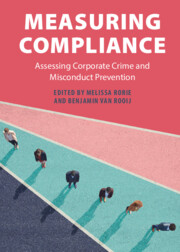Book contents
- Measuring Compliance
- Measuring Compliance
- Copyright page
- Contents
- Figures
- Tables
- Contributors
- 1 Measuring Compliance: The Challenges in Assessing and Understanding the Interaction between Law and Organizational Misconduct
- Part 1 The Compliance Industry, the State, and Measurement Needs
- Part 2 Quantitative Approaches to Measuring Corporate Compliance
- Part 3 Qualitative Approaches to Measuring Corporate Compliance
- 11 Engaging Qualitative Research Approaches to Investigate Compliance Motivations: Understanding the How and Why of Compliance
- 12 Admitting Noncompliance: Interview Strategies for Assessing Undetected Legal Deviance
- 13 Compliance Ethnography: What Gets Lost in Compliance Measurement
- Part 4 Mixed Methods and Building on Existing Compliance Research
- Index
- References
12 - Admitting Noncompliance: Interview Strategies for Assessing Undetected Legal Deviance
from Part 3 - Qualitative Approaches to Measuring Corporate Compliance
Published online by Cambridge University Press: 17 February 2022
- Measuring Compliance
- Measuring Compliance
- Copyright page
- Contents
- Figures
- Tables
- Contributors
- 1 Measuring Compliance: The Challenges in Assessing and Understanding the Interaction between Law and Organizational Misconduct
- Part 1 The Compliance Industry, the State, and Measurement Needs
- Part 2 Quantitative Approaches to Measuring Corporate Compliance
- Part 3 Qualitative Approaches to Measuring Corporate Compliance
- 11 Engaging Qualitative Research Approaches to Investigate Compliance Motivations: Understanding the How and Why of Compliance
- 12 Admitting Noncompliance: Interview Strategies for Assessing Undetected Legal Deviance
- 13 Compliance Ethnography: What Gets Lost in Compliance Measurement
- Part 4 Mixed Methods and Building on Existing Compliance Research
- Index
- References
Summary
Abstract: One of the core challenges in compliance measurement is to assess and analyze undetected instances of illegal behavior. This chapter discusses interview strategies to best capture such deviant conduct and the factors of influence on it. It discusses two core approaches. First is the informant approach, where multiple rounds of interviews with key informants with deep knowledge of the regulated organization are combined and triangulated to construct a case study of what happened in the organization and what influenced it. Second is the respondent approach, where the same interview is held once with a larger group of similar actors in regulated organizations to understand and compare how these individual actors see compliance and the forces that shape it. The chapter discusses for what purposes each of these approaches is best suited, what their strengths and weaknesses are, and how they can best be conducted. It shows the importance of a pilot study, proper interview design, and thorough preparation in interview techniques used during the actual interview.
- Type
- Chapter
- Information
- Measuring ComplianceAssessing Corporate Crime and Misconduct Prevention, pp. 202 - 217Publisher: Cambridge University PressPrint publication year: 2022
References
- 1
- Cited by

